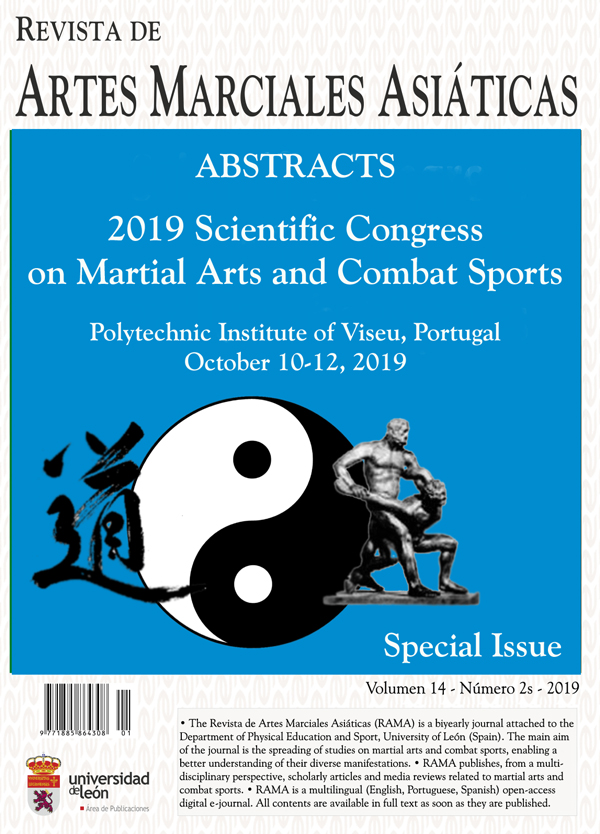What happens during a teaching-learning process of martial arts and combat sports with novice – A case-study focused on the joint activity organization analysis
DOI:
https://doi.org/10.18002/rama.v14i2s.6020Keywords:
Martial arts, combat sports, constructivism, interactivity, activity organization, guided practice, fighting knowledgeAbstract
Semiotic devices are relevant tools to study the teaching-learning process according to the constructivist perspective, which supports several of the game-centered approach models. Even not being included in the generality of these models, martial arts and combat sports have a clear potential to be developed according to these models. Following this, it was settled a didactic sequence based on the fighting knowledge development through the learning of a striking and a throwing skill. A pragmatic discourse analysis was made and specific forms of joint activity organization, called segments of interactivity, were identified. Inside these segments, several patterns were registered considering their main function and format of interaction. The segments of interactivity of activity organization and guided practice constituted both the bigger part of the time and total number of segments, which suggest that the learning processes should be understood inside of their scope. This way, looking for the activity organization, the predominance of the patterns related with “execution” evolve according with the appropriation of the contents, while the “function” patterns seem to be more relevant when it is proposed a new or more complex task. By the other hand, the results related to guided practice segments remark the importance of the one-to-one interactions between the teacher and the apprentice within the whole classes situation. These results show the singularity of every teaching-learning process in terms of the progressive transfer of control and responsibility from the teacher to the apprentice and the simultaneous establishment of an increasingly rich network of shared meanings between these agents.
Downloads
Métricas alternativas
References
Amade-Escot, C. (2000). The contribution of two research programs on teaching content: “pedagogical content knowledge” and “didactics of physical education”. Journal of Teaching in Physical Education, 20(1), 78-101. doi: https://doi.org/10.1123/jtpe.20.1.78
Avelar-Rosa, B., Gomes, M.S.P., Figueiredo, A., & López-Ros, V. (2015). “Fighting knowledge” characterization and development: contents of an integrated model for teaching martial arts and combat sports. Revista de Artes Marciales Asiáticas, 10(1), 16-33. doi: http://dx.doi.org/10.18002/rama.v10i1.1501
Coll, C., Onrubia, J. & Mauri, T. (2008). Supporting learning in educational context: the exercise of educational influence and the analysis of teaching. Revista de Educación, 346, 33-70.
Llobet-Martí, B., López-Ros, V., & Vila, I. (2018). The analysis of interactivity in a teaching and learning sequence of rugby: the transfer of control and learning responsibility. Physical Education and Sport Pedagogy, 23(1), 84-102. doi: https://doi.org/10.1080/17408989.2017.1341472
López-Ros, V. & Castejón, F.J. (2005). Integrated teaching of technical-tactic sports during school years. Apunts. Educació Física i Esport, 79, 40-48.
Vigotsky, L.S. (1978). Mind in Society: The development of higher psychological processes. Cambridge MA: Harvard University Press.
Wood, D., Bruner, J.S., & Ross, G. (1976). The role of tutoring in problem-solving. Journal of Child Psychology and Psychiatry, and allied disciplines, 17, 89-100. doi: http://dx.doi.org/10.1111/j.1469-7610.1976.tb00381.x
Wright, J., & Forrest, G. (2007). A social semiotic analysis of knowledge construction and games centred approaches to teaching. Physical Education and Sport Pedagogy, 12(3), 273-287. doi: https://doi.org/10.1080/17408980701610201
Downloads
Published
How to Cite
Issue
Section
License
Copyright (c) 2019 Bruno Avelar-Rosa, Víctor López-Ros

This work is licensed under a Creative Commons Attribution-NonCommercial-ShareAlike 4.0 International License.
The authors who publish in this journal must agree to the following terms:
- The authors grant on a nonexclusive basis the exploitation rights (reproduction, distribution, public communication and transformation) of the work accepted for publication to the University of León. The authors can establish, on their own, additional agreements for the non-exclusive distribution of the version of the work published in the journal (for example, placing it in an institutional repository or publishing it in a book), always acknowledging the initial publication in this journal.
- This work is licensed under the Creative Commons Attribution-NonCommercial-ShareAlike 4.0 International License. Click to see basic information and the legal text of the license.
- The authors are allowed and encouraged to disseminate electronically pre-print or post-print versions of their work before publication, as this can give rise to productive exchanges, as well as earlier and increased citing of the works published.











